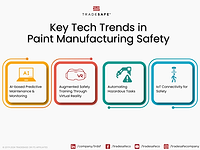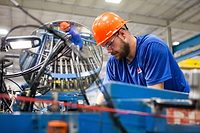Unique Safety Hazards in Paint Manufacturing, and How to Combat Them

Image courtesy of bsd555, iStock / Getty Images Plus, via Getty Images.
The paint manufacturing industry generates over $31 billion in revenue, annually. This field is clearly a lucrative one. However, for those who work in this space to remain profitable, businesses must take proactive measures to avoid accidents and injuries that interfere with productivity.
This article discusses some unique safety hazards affecting professionals in the paint manufacturing space, as well as original equipment manufacturers (OEMs) that regularly utilize paint in their plant operations. It also offers advice on how employers, managers, and other leaders can combat these dangers.
Safety Hazards in Paint Manufacturing
Paint manufacturing workers experience various challenges, and health and safety risks while on the job. The following are some of the most frequently experienced ones:
Chemical Exposure
Exposure to chemicals is one of the most critical health and safety risks to be aware of when working in the paint manufacturing field. Whether chemicals are inhaled while the paint is being mixed or makes contact with the skin when the paint is applied to a surface, employees can experience serious health problems when exposed, including:
- Irritation or damage to the eyes, mucous membranes, respiratory tract, digestive tract, and skin caused by the vapors of solvents, paints, lacquers, and their components.
- Nervous system damage caused by exposure to organic substances like toluene, methyl-alcohol, and n-hexane.
- Dermatitis caused by skin exposure to paint components like aromatic hydrocarbons and organic halogen compounds, as well as pigments containing cobalt or chrome.
Working at Great Heights
In paint application or manufacturing positions, it is common for employees to spend significant amounts of time working at great heights. When working from a ladder, platform, etc., the risk of falls, and the injuries they can cause, such as fractures and head trauma, increases. Even when employees have access to safety equipment like harnesses, it is still difficult to prevent accidents and injuries entirely.
Slips and Trips
On the ground, employees in paint manufacturing facilities also face risks, including the risk of slips and trips. Working with paint, solvents, lacquers, and their various components naturally introduces the potential for spills. If spills aren’t addressed promptly, they can cause employees to slip, which in turn creates a risk of fractures and other skeletomuscular injuries. Furthermore, there is also a risk of employees tripping over equipment, especially equipment that is not put away correctly, and experiencing similar injuries.
Uncomfortable Working Positions
Both painting and paint manufacturing processes frequently require employees to work in uncomfortable, unnatural positions. With consistent bending, stretching, reaching, and standing, employees face an increased risk of musculoskeletal injuries, from strained and sprained muscles to chronic pain and repetitive motion injuries.
Noise Exposure
Any position in the manufacturing world, including paint manufacturing positions, can include exposure to loud noises from machinery and equipment. Ongoing noise exposure, especially if it exceeds 85 decibels, can increase employees’ risk of hearing damage, as well as other physical and mental health problems like anxiety, depression, hypertension, and heart disease.
Paint Manufacturing Safety Cornerstones
Working in paint manufacturing presents numerous challenges, whether one is involved in the paint-making process or uses paint regularly as part of their job. However, employers and managers can take many steps to protect their employees and maximize productivity. The most critical safety cornerstones for the industry are listed below:
Effective Communication
Clear and consistent communication can mitigate many of the health and safety risks associated with working in the paint manufacturing industry. What does effective communication look like in action? It should involve the following:
- Instructions delivered at the beginning of each shift so that employees know exactly what they should be doing and where they should be.
- Instructions supplied before machinery operation begins to prevent mishearing or misinterpretation.
- Instructions provided in multiple languages, if needed, so everyone understands and is on the same page.
- Opportunities for employees to ask questions or seek clarity, as needed, without fear of criticism or adverse consequences.
Indoor Air Quality Monitoring
If employees are responsible for making paint or using it in daily plant operations (such as painting furniture), they risk health complications associated with chemical vapor inhalation. Indoor air quality monitoring helps to reduce the chances of chemical inhalation and the symptoms it can cause, such as lightheadedness, headaches, or coughing. Employers should utilize indoor air quality monitors and service them regularly to ensure they’re functioning correctly. They should also educate employees on the signs of chemical vapor inhalation so that they can seek help promptly.
Appropriate Personal Protective Equipment
The use of personal protective equipment (PPE) will significantly reduce the severity of many of the hazards in the paint industry. For example, clothing that fully covers the skin (including thick, durable gloves) will help to prevent topical chemical exposure. Masks and goggles further protect sensitive areas of the body (such as the eyes and nose) from harmful chemicals and vapors. Ear plugs or earmuffs also reduce the risk of hearing damage caused by prolonged loud noise exposure.
Regular Breaks
Regular breaks give employees an opportunity to stretch and avoid holding uncomfortable positions for extended periods. These breaks also allow for sufficient rest, which further reduces the risk of physical injury while on the job (as well as mistakes that could slow down production or result in injuries).
Adequate and Ongoing Safety Training
Employees should receive comprehensive safety training and information regarding the hazards of the job at the beginning of their employment period. For example, employees who are responsible for painting or refinishing vehicles should learn about the risk of inhaling paint fumes or falling when climbing ladders. Employers in manufacturing settings should organize regular safety meetings to ensure that all employees receive timely reminders and updates on safety protocols throughout their tenure.
Harmonizing Safety Measures and Communication in Paint Manufacturing
It doesn’t matter if they work in a paint manufacturing plant or an OEM that uses paint in the manufacturing process, employees in the paint space still face hazards like chemical exposure (through inhalation or physical contact) and the risk of slips, trips, and falls.
However, with adequate training, consistent air quality monitoring, and other preventative measures, employers can combat these unique threats, protect employees, and maintain efficient plant operations. A commitment to safety will benefit all parties.
Looking for a reprint of this article?
From high-res PDFs to custom plaques, order your copy today!






